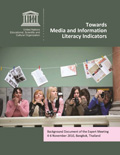Towards Media and Information Literacy Indicators
 Background Document of the Expert Meeting
Background Document of the Expert Meeting
4-6 November 2010, Bangkok, Thailand
Developing a Global Framework for a topic as broad and complex as Information Literacy-Media Literacy or, to use UNESCO’s appellation, Media and Information Literacy (MIL) Indicators is a daunting task. To address this challenge, a brief overview of the history, background, and global context is needed.
It is fundamental to ensure that all people have the competencies – knowledge, skills, and attitudes – to succeed throughout all stages of the life cycle of both ‘information’ and ‘media,’ and to help people meet their needs, thrive, and improve the quality of their lives.
Media and information literacy begins with the creation of content, based on a collection of raw data. The data may be gleaned from a diverse array of sources, such as written documents, an oral expression of indigenous knowledge, a live news report, a work of art, observations of a live giraffe, or a digital readout from a satellite or medical device. The content produced can take on one form or many.
Many types of content are subsequently managed and organized, perhaps using a formal indexing system or tags determined by individuals (often referred to as folksonomies). For example, photographs and videos of an event may be posted on a website along with identifying information. An individual, upon seeing the site, may add personal information (such as the name of an individual in the video and historical information about the location), thereby enhancing the content. Metadata systems may be used to link to different types of content (e.g., reported news articles and broadcasts or opinion pieces, such as editorials and blogs).
The term ‘content’ can be understood differently, depending on one’s relationship to its production and dissemination. For a producer of information, content may an expression of explicit knowledge, the integrity of which can be protected (e.g. by copyright). For a recipient, content may be the information to answer to a question, a work of art that inspires creative thought, or a map to help find the way to a destination.
Access to, dissemination of, and, most importantly, the capacity for critical evaluation of content are essential to help people select reliable information/data. Providing access to content, such as posting it on a website, is more passive than actively disseminating it in the form of an email, a Tweet, or even a printed flyer. Active dissemination may be needed in cases of emergencies, such as an impending hurricane or a defective children’s product. The process of evaluating information, though complex, is essential to effective decision-making, whether in voting, selecting the best medication, or identifying the best course of action.
Throughout the life cycle, values, ethical reasoning, and critical thinking must be brought into each stage, recognizing that values vary among cultures.
Within the global, multicultural context, the complete set of competencies needed for all stages of the life cycle comprise MIL, including other relevant literacies. This background document provides a framework for the development of concepts (variables) and their corresponding measurements (indicators) to assess MIL competencies within a global context.
This document draws upon extensive previous work, the perspectives of many experts around the world, and numerous discussions at workshops and conferences. Its purpose is threefold. First, it provides key, related, and common elements in defining media and information literacy (MIL) and its learning outcomes. Second, it provides a rationale for a conception of MIL as a collective set of interrelated competencies (knowledge, skills, and abilities) necessary for education today. Finally, it identifies and describes some of the challenges in developing measurable variables and ideas for evaluating the trade-offs in selecting indicators.
The importance of understanding cultural and other important differences must be stressed throughout. Different categories of MIL variables are provided in two tiers: MIL Initiatives within Society and MIL within Formal Education Systems. Supplementary material, including major definitions of media and information literacy and key competencies, along with the tables of the variables are included in the appendices.
The goal of this document is to provide background and an overview of previous work on MIL and to propose a series of variables that can be used in the future to develop specific and measurable indicators*. UNESCO and the authors also hope that this document will encourage further discussion and investigation into this complex and important topic.
Download:
Background Document of the Expert Meeting Towards Media and Information Literacy Indicators [PDF]
*In the recognition of the fact that more work needs to be done in order to elaborate specific and measurable MIL indicators, a term “variables/indicators” is used throughout the document.